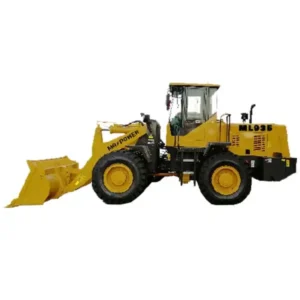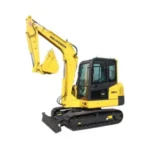Einführung

In the domain of heavy machinery used in construction, mining, and material handling, bucket wheel loaders stand out for their robust design and multifunctionality. These machines are integral to various industrial operations due to their efficiency in loading, transporting, and stockpiling bulk materials. This blog delves into the intricacies of bucket wheel loaders, exploring their features, applications, maintenance requirements, and technological advancements.
Was ist ein Bucket Wheel Loader?
A bucket wheel loader is a specialized type of heavy equipment equipped with a large wheel fitted with buckets around its circumference. These buckets scoop up materials such as earth, gravel, sand, and other bulk commodities and transfer them to trucks, conveyors, or stockpiles for further processing or transport. The size and capacity of wheel loaders vary widely based on the specific application and operational needs.
History and Development
The evolution of bucket wheel loaders spans several decades, evolving from simple mechanical designs to sophisticated hydraulic systems and automation. Initially developed for mining purposes to handle large volumes of materials efficiently, these loaders have since expanded their applications to construction, quarrying, waste management, and port operations. Technological advancements have enhanced their productivity, reliability, and safety features, making them indispensable in modern industrial settings.
Key Features and Components
Key components of bucket wheel loaders include the bucket wheel, boom arms, hydraulic cylinders, and the operator cab. Modern loaders often feature advanced control systems that optimize performance, improve precision, and enhance operator comfort and safety. Understanding these components and their functionalities is crucial for maximizing operational efficiency and minimizing downtime.
Branchenübergreifende Anwendungen
Bucket wheel loaders find extensive use across various industries due to their versatility and capability to handle diverse materials. In mining operations, they are employed for excavating and transporting ore and overburden. In construction sites, they facilitate the loading of aggregates, debris removal, and material handling tasks. These machines also play a pivotal role in port operations for loading and unloading bulk cargo from ships.
Vorteile von Bucket Wheel Loaders
The primary advantages of wheel loaders include high productivity, efficiency in material handling, and the ability to operate in challenging terrains and environments. They can significantly reduce labor costs and operational time by quickly moving large quantities of materials. Their robust construction and ergonomic design contribute to prolonged operational life and minimal maintenance requirements compared to other types of loaders.
Case Studies and Performance Metrics
To illustrate the effectiveness of bucket wheel loaders, case studies from various industries can be examined. For instance, in mining operations, these machines have been instrumental in increasing ore extraction rates and reducing loading times. In construction projects, they have helped in achieving project timelines by efficiently handling construction materials and debris.
Comparative Analysis of Bucket Wheel Loaders
| Feature | Bucket Wheel Loader | Comparison with Other Loaders |
|---|---|---|
| Capacity (tons) | High | Moderate to High |
| Efficiency | Excellent | Good to Excellent |
| Vielseitigkeit | Medium to High | Low to Medium |
| Maintenance Requirements | Moderate | Moderate to High |
| Operational Costs | Moderate | Moderate to High |
Understanding Maintenance and Service Needs

Effective maintenance practices are essential for optimizing the performance and longevity of wheel loaders. Regular inspections, lubrication, and timely replacement of wear parts are crucial to prevent breakdowns and ensure safe operation. Manufacturers often provide detailed maintenance schedules and guidelines tailored to specific models and operating conditions.
Abschluss
Abschließend, bucket wheel loaders represent a cornerstone of efficiency and versatility in heavy machinery applications. Their evolution from simple mechanical systems to advanced hydraulic and automated designs has revolutionized industrial operations across various sectors. Understanding their features, applications, and maintenance requirements is essential for leveraging their full potential in enhancing productivity and operational efficiency.
FAQ
Q:What are the primary applications of bucket wheel loaders?
A:Bucket wheel loaders are primarily used for loading, transporting, and stockpiling bulk materials such as earth, gravel, and ore in industries like mining, construction, and ports.
Q:How do wheel loaders compare to other types of loaders?
A:Wheel loaders excel in handling large volumes of materials efficiently over short distances, distinguishing them from wheel loaders and excavators which may have different strengths in versatility or precision.
Q:What factors should be considered when selecting a bucket wheel loader?
A:Factors such as bucket capacity, reach, engine power, and operational environment (terrain, climate) are critical in choosing the right loader for specific applications.
Q:How can maintenance prolong the life of a bucket wheel loader?
A:Regular maintenance, including inspections, lubrication, and timely replacement of wear parts, is essential for preventing breakdowns and ensuring longevity.
Q:What are some emerging trends in bucket wheel loader technology?
A:Trends include advancements in automation, integration of telematics for remote monitoring, and improvements in fuel efficiency and emissions reduction.








-150x150.webp)
